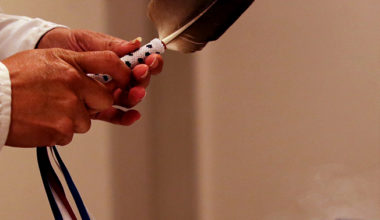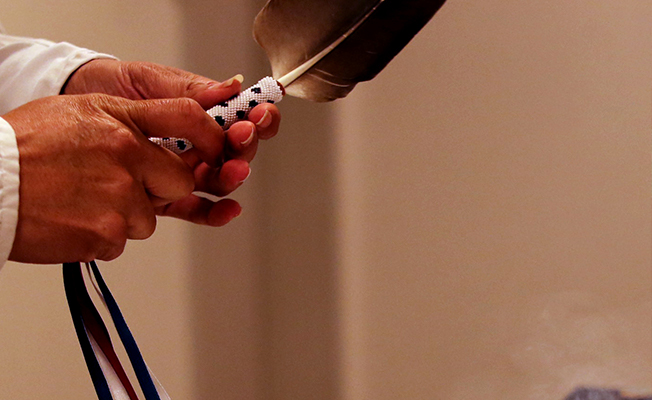“It is difficult to address HIV, HCV, and STBBI if these concepts do not exist within a language or culture…” wrote the DRUM & SASH team in an abstract presented at the 2021 Annual Canadian Conference on HIV/AIDS Research (CAHR). This statement represents the complexities and intractable reality of the ongoing efforts to address these health issues in many Indigenous communities.

DRUM & SASH: Development of a Rural Model for Integrated Shared Care in First Nation and Métis Communities.
First Nation, Inuit, and Métis across Canada face HIV infection rates that are nearly triple that of non-Indigenous Canadians, and much higher rates of HIV-related mortality. Time and again, we have seen that programs and interventions designed for non-Indigenous peoples do not work to the same degree in Indigenous populations. Furthermore, when researchers and health professionals set out to develop programs specifically for Indigenous communities, they have often relied on a pan-Indigenous approach, assuming that what works for one Indigenous community will work for all.
Rather than developing and testing an intervention intended to work in all communities, the DRUM & SASH team, supported in part by the CTN through CTN 301-2, is developing a framework that can be used and adapted to engage in relevant and meaningful ways with individual Indigenous communities.
To accomplish this, DRUM & SASH is partnered with communities across Alberta and Saskatchewan.
Cultural resurgence as a source of strength
The DRUM & SASH team, which includes community research partners, has engaged with Elders and community members from several First Nation and Métis communities to develop community-led initiatives to prevent and treat HIV and other STBBI. These efforts focus on strengths and are grounded in language and culture. Led by CAAN Communities, Alliances and Networks (CAAN) with the Universities of Victoria and Saskatchewan in a community–campus partnership that further extends to participating First Nation and Métis communities, this project has evolved over many years.
It all starts with acknowledging the historical context in which the work is taking place, says CTN Investigator Dr. Catherine Worthington, who co-leads the team with Renée Masching for CAAN and CTN Investigator Dr. Alexandra King. “It’s about recognizing that communities have very distinct and well-developed cultures, norms, values, and appropriate ways of doing things for themselves,” she explained. “We acknowledge the deep wisdom there and that it doesn’t make sense to develop programs without recognizing community strengths, particularly given the history of colonization and the things that have been done to them.”
In this project, the work begins with helping a community to know where to start. Carrielynn Lund, the Research Coordinator for DRUM & SASH, explains how the team uses the Community Readiness Tool, originally developed by a Colorado University team and adapted by CAAN for their work.

DRUM & SASH and Miyo-pimâtisiwin (the good life), an Indigenous wellness knowledge development project supported by the College of Medicine at the University of Saskatchewan. This group picture was taken in the community of Île-à-la-Crosse in northern Saskatchewan.
“We train communities on how to use this survey to establish the level of readiness to address HIV. This tool gives a score between one and nine — nine being ‘We’ve got this, we don’t need any help’, and one being ‘Don’t even say the word’,” she said. “We then support them in developing initiatives and messaging that are appropriate for their level of readiness to move forward.”
In addition, the team has worked with Elders and community members to develop traditional language for the discussion of HIV, HCV, STBBI, and related topics such as sexual health and sexuality.
Lund describes their work helping the community consider creating new words for use in the discussion of wellness.
“The Elders spoke of how language currently being used around HIV, hep C, and STBBI, including the word ‘sex’ is harsh and people don’t want to talk about it,” she explained. “Prior to residential schools, there was no such thing as words for an act of sex. It was part of life. But with the residential schools and the sexual abuse that happened there, the word sex became an act that harmed children and resulted in a lot of pain and shame. Using the word now can, and often does, trigger a negative response and people shut down and turn away”
The DRUM & SASH team supported Elders to “negotiate” the creation of new words to be used in discussing HIV, hepatitis C, and related mental health and stigma. Lund describes how, during these efforts, both community partners and the DRUM & SASH team learned that including the local language and imagery on things like posters and fact sheets makes the messaging much more meaningful and more likely to result in more people reading them.
“People could see their language and knew that it was a local effort; they could see that this was not from Health Canada or the provincial government, and it sparked more interest,” explained Lund.
“There’s an element of cultural resurgence and community development in bringing language back into the health area, by allowing people to see that their ways of understanding are included and embedded, leading the way when an issue is being discussed and developed,” added Dr. Worthington.
Together with strengths-based and community-grounded approaches, the theme that runs through this work is one of reciprocal learning. This means that Elders, community members, including health service providers, and DRUM & SASH team members learn from each other. The sharing of knowledge about language, culture, STBBI, and concepts of health all contribute to building trust and respectful relationships to further STBBI prevention and treatment.

Carrielynn Lund (front left) with members of the DRUM & SASH team.
It’s not a product, it’s a process
As the DRUM & SASH team engages with more communities, and in different aspects of health and wellness within those communities, the focus shifts and the approach is adapted.
“Each community is going at their own pace with their own knowledge, resources, and language, and their own culture and traditions,” explained Dr. Rachel Landy, a postdoctoral fellow working with Dr. Worthington on the project. “As part of maintaining a responsible, ethical relationship with our local partners, community coordinators are involved in all aspects of the project, including reporting back to their leadership. In some cases, publications are coming, with community co-authors, but these fall later on in the process.”
A component of this ethical and trustful relationship is acknowledging community ownership of the process and programs. In this context, communities own the research, and nothing is reported or shared about the community unless the community makes a request. In this way, capacity strengthening includes program development and ideas about the research, dialoguing with the research team’s guidance and management committee, and learning together.
Knowledge translation activities are integrated throughout the project. In some cases, there are circumstances that support the publication or sharing of information about the work. For example, in collaboration with Shining Mountains Living Community Services in Red Deer, the team has developed Métis-specific models of STBBI care and testing. These learnings were shared at CAHR conferences in 2020 and 2021. Community sharing has included hosting local gatherings and meetings with Elders.

Carrielynn Lund and Raye St. Denys, the Executive Director of Shining Mountain Living Community Services, presenting at the North American Hepatitis Elimination Summit in February, 2023.
Critically, the DRUM & SASH team is mindful of the diversity of the communities engaged in the project in Alberta and Saskatchewan. Northern and Southern First Nations and Métis locals share common values and but also have unique perspectives. “Métis communities are often expected to use resources that are adapted from resources developed for, or by, First Nation communities who have different cultural beliefs and norms from Métis communities,” the team wrote in a 2021 abstract, highlighting the need for community-specific approaches.
As an approach to potentially increase access to STBBI testing, the team has also worked with the Red Deer Métis community to evaluate the acceptability of dried blood spot testing from a community perspective. The testing program was already underway, but the team was able to use it as a way to think about strengths-based and implementation approaches.
“We didn’t choose dried blood spot testing as an area that we could pilot and test a way of working together,” explained Dr. Worthington. “It emerged through conversations as an innovation that some communities were very interested in. So, we picked it up, acted as broker with Alberta Health Services, and used it as a first way of working with the community around a particular ‘intervention’.”
Despite some success in translating their work into formal publications, the team stresses that their main goal is to strengthen capacity within communities. As a community-based research project, the primary stakeholders and ‘audience’ for this research are the people who will be using it every day. The focus is day-to-day functioning of health programming or services, and for meeting the knowledge needs of our community partners. By incorporating new approaches and learnings from their work, the team is, piece by piece, developing a set of malleable, adaptable best practices for community development.
Reflecting Indigenous values and approaches in research, this project recognizes it’s not about a product, it’s about process. The process is to make sure that communities hear about what others are doing, learn to model that, and then adapt it for local activities and priorities.
“What we have seen from a practical standpoint, which has been really exciting, is communities teaching communities. For instance, our Métis Saskatchewan partner team members came and shadowed and learned hands-on from Alberta Métis and from the other partners,” said Lund. “This cross-community collaboration is part of our vision for DRUM & SASH.”
To learn more about DRUM & SASH, visit https://www.drumandsash.ca/.


